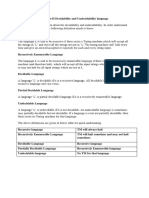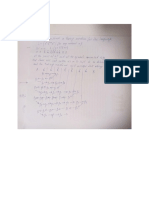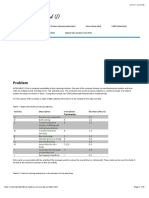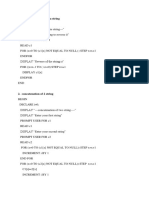Marcela Reyna
Marcela Reyna
Uploaded by
Marcela ReynaCopyright:
Available Formats
Marcela Reyna
Marcela Reyna
Uploaded by
Marcela ReynaCopyright
Available Formats
Share this document
Did you find this document useful?
Is this content inappropriate?
Copyright:
Available Formats
Marcela Reyna
Marcela Reyna
Uploaded by
Marcela ReynaCopyright:
Available Formats
Marcela Reyna
Computation HW Chapter 7:
7. Show that P is closed under union, concatenation, and complement.
a. UNION
For any two P languages L1 and L2, Let M1 and M2 be the TMs that decide them in
polynomial time time. We construct TM M' to recognize the union of L1 and L2 in
polynomial time.
“On input w:
1. Run M1 on w. If it accepts, accept.
2. Run M2 on w. If it accepts, accept. Otherwise reject.”
M' accepts w is either M1 or M2 accepts it. If both reject, M' rejects.
b. CONCATENATION
To prove polynomial Language P is closed under concatenation, the TM M (for L=L1L2)
considers all possible partitions xy of string w, runs TM M1(of L1) on x and TM M2 (of
L2) on y and accepts if and only if both accept for some partition w=xy.
For any Polynomial timed Language P where L=L1L2, let the TM M consider all
possible partitions xy of string w.
“On input w:
1. Run M1 on x. If it accepts, accept.
2. Run M2 on y. If it accepts, accept. Otherwise, reject.”
M accepts w if and only if both M1 and M2 accept some partition w=xy.
c. COMPLEMENTATION
For any Polynomial Time Language L1, let M1 be the TM that decides them in
polynomial time. We construct a TM M' that decides the complementation of L1 and
L2:
“On input w:
Run M1 on w. If it accepts, reject.
If it rejects, accept.”
Because it is a complement, every time the machine accepts, we will do the opposite,
so we will reject and vice versa.
7. Show that NP is closed under union and concatenation.
a. UNION
For any two NP languages L1 and L2, Let M1 and M2 be the NDTMs that decide them in
polynomial time time. We construct NDTM M' to recognize the union of L1 and L2 in
polynomial time.
“On input w:
1. Run M1 on w. If it accepts, accept.
2. Run M2 on w. If it accepts, accept. Otherwise reject.”
M' accepts w is either M1 or M2 accepts it. If both reject, M' rejects.
b. CONCATENATION
To prove NP is closed under concatenation, the NDTM M (for L=L1L2) considers all
possible partitions xy of string w, runs TM M1(of L1) on x and TM M2 (of L2) on y and
accepts if and only if both accept for some partition w=xy.
For any NP Language where L=L1L2, let the NDTM M consider all possible partitions
xy of string w.
“On input w:
1. Run M1 on x. If it accepts, accept.
2. Run M2 on y. If it accepts, accept. Otherwise, reject.”
M accepts w if and only if both M1 and M2 accept some partition w=xy.
7.10 Show that ALLdfa is in P.
ALLdfa is the set of every language that is deterministically computed, in other words,
there is always a finite number of steps to be computed and the machine never has to
make any decisions, it always knows its next state. The class P is defined as a class of
languages that are decidable in polynomial time on a deterministic single tape Turing
machine. So, given a TM where we run an input string w, if it is accepted as decidable in
polynomial time, then it is Deterministic and therefore in Class P.
Modification of Theorem 4.1
M= “On input<B,w>, where B is a DFA and w is a string:
1. Simulate B on input w.
2. If the simulation ends in an accept state, accept. If it ends in a non-accepting state,
reject.”
If input is accepted, then it is in class P, else it is not in class P.
7.17 Show that, if P=NP, then every language A is an element of P, except A=empty set
and A=sigma*, is NP Complete.
Assume P=NP
Let A be any language in NP such that A does not equal empty set and A does not equal
sigma star. Thus, there exists strings w1, w2 which are elements of sigma star such that
w1 is an element of A but w2 is not an element of A.
We will show that A is NP-hard. Let L be any other language in NP. Since P=NP, we
know that L can be decided in polynomial time. Give a string w, we give a polynomial-
time computable function f such that w is an element of L if and only if f(w) is an
element of A. The function f is computed as follows. On input w, decide in polynomial
time if w is an element of L. If yes, set f(w)=w1. Else, set f(w)=w2. Clearly, w is an
element of L if and only if f(w) is an element of A. Thus, A is NP-complete. We needed
to exclude A equals empty set otherwise we would have had no candidate f(w) if w is
an element of L. Similarly, we needed to exclude A = sigma star as otherwise we
would have had no candidate f(w) if w is an element of L.
7.27 A coloring of a graph is an assignment of colors to its nodes so that no two
adjacent nodes are assigned the same color. Let 3COLOR={G| the nodes of G can be
colored with three colors such that no two nodes joined by an edge have the same
color}
Show that 3COLOR is in NP complete. (HINT: use the following three subgraphs.)
We prove 3COLOR is NP complete
Construction of a graph which can be colored with n+1 colors.
• Make all variables {v1, ... , vn} and their complements vertices of the graph.
• Connect each variable to its complement, each one must be colored differently, so each
pair has a true and false.
• Make the true colors to be different from each other.
• Create a new set of vertices called {x1,...,xn} and have them all connected to each other.
• The n xi's now form a clique.
• Connect each xi to each vj and their complements except with i=j.
Reduce 3-SAT to COLOR
Add a vertex for each clause and name them c1, ... , cr. Connect each of them to all the
variables and their complements except for the three literals which are in the clause. We now
have the following edges in our graph for all i and j between 1 and n, and k between 1 and r.
All the true variables must be different because the xi's form a clique. So, all the ci's are
connected to all the non ci's.
Suppose that there is a truth assignment to the variables which satisfies all of the ci. Color
each true variable with appropriate ti and color its complement false. One of its literals must
have been colored with one of the true colors since the clause is satisfied. The vertex ci can
be colored that way too since it is not connected to that literal. That makes exactly n+1 colors
for all the vertices of the graph.
If there is no truth assignment which satisfies all of the clauses, then for each of these
assignments there must be a clause (ci) which has all its literals colored with the false or
(n+1)-st color. This means that ci is connected to vertices of every true color since it is
connected to all those it does not contain. And since it is connected to all but three of the
literal vertices, it must be connected to a vertex colored false also since there are at least
three variables. Thus the graph cannot be colored with only n+1 colors.
Now, it is shown that 3-SAT £ p COLOR and therefore COLOR is NP-complete since making
the graph is done is polynomial time.
You might also like
- CLRS SolutionsDocument530 pagesCLRS Solutionsmehdivakili79No ratings yet
- Computation HW#1Document3 pagesComputation HW#1Marcela ReynaNo ratings yet
- Mathematics Assignment For Grade 12 On Limits and ContinuityDocument3 pagesMathematics Assignment For Grade 12 On Limits and ContinuityKhalid A.No ratings yet
- HW 3 AnsDocument5 pagesHW 3 AnsdelinneNo ratings yet
- Unit V UndecidabilityDocument23 pagesUnit V UndecidabilityBerlin ShaheemaNo ratings yet
- Unit V Undecidability: 5.1.1 Decidable ProblemDocument23 pagesUnit V Undecidability: 5.1.1 Decidable ProblemBerlin ShaheemaNo ratings yet
- 06 CS56 FLATUnit 8Document4 pages06 CS56 FLATUnit 8fencyNo ratings yet
- Chapter-II Enumerators: Universal Turing MachineDocument13 pagesChapter-II Enumerators: Universal Turing MachineDinaol HabtamuNo ratings yet
- Homework 7 SolutionsDocument3 pagesHomework 7 Solutionsdhea septieNo ratings yet
- Theory of Computation Practice QuestionsDocument6 pagesTheory of Computation Practice QuestionsShahzebNo ratings yet
- Computability and Complexity - Solution of 2008 Moed A ExamDocument4 pagesComputability and Complexity - Solution of 2008 Moed A Examjerry handyNo ratings yet
- CT Test 2 PortionDocument9 pagesCT Test 2 PortionDinaol HabtamuNo ratings yet
- Lecture 15: Computing With Turing MachinesDocument13 pagesLecture 15: Computing With Turing Machineswenqiang0716No ratings yet
- Decidable and Undecidable ProblemsDocument27 pagesDecidable and Undecidable ProblemspoiuytrewqNo ratings yet
- 18CS54 - Atci - Module 5 - Decidability & ApplicationsDocument33 pages18CS54 - Atci - Module 5 - Decidability & ApplicationsMohammad RafiNo ratings yet
- CSE HW 3 Solutions ManualDocument4 pagesCSE HW 3 Solutions ManualGaurav RajNo ratings yet
- Problem Set 2: F (N) Logf (N) o (F (N) ) Log (O (F (N) ) )Document3 pagesProblem Set 2: F (N) Logf (N) o (F (N) ) Log (O (F (N) ) )hawk100% (1)
- HW 1 SolutionsDocument3 pagesHW 1 SolutionsMd Johirul IslamNo ratings yet
- Home AlgorithmsDocument4 pagesHome AlgorithmsAlimov OlimxonNo ratings yet
- Toc PDFDocument30 pagesToc PDFSmit ThakkarNo ratings yet
- Homework 7 SolutionsDocument2 pagesHomework 7 SolutionsDivyesh KumarNo ratings yet
- Homework 7 Solutions: 1 2 K I J 1 2 KDocument4 pagesHomework 7 Solutions: 1 2 K I J 1 2 KTP PROXYNo ratings yet
- Automata Notes PDFDocument29 pagesAutomata Notes PDFRaj Kumar YadavNo ratings yet
- Recursive and Recursively Enumerable Languages: Prof. (DR.) K.R. ChowdharyDocument11 pagesRecursive and Recursively Enumerable Languages: Prof. (DR.) K.R. ChowdharySatish KumarNo ratings yet
- Practise QuestnsDocument6 pagesPractise QuestnsMegha GandhiNo ratings yet
- Qba Unit-V Flat 22-23Document9 pagesQba Unit-V Flat 22-23ikrisshna08No ratings yet
- Homework By:: Pratik Pranav - 2018CS10368 Sarthak Behera - 2018CS10384 Shreyans Nagori - 2018CS10390Document4 pagesHomework By:: Pratik Pranav - 2018CS10368 Sarthak Behera - 2018CS10384 Shreyans Nagori - 2018CS10390pratik pranav100% (1)
- A Non-Turing-Recognizable Language: VerviewDocument5 pagesA Non-Turing-Recognizable Language: Verviewmi6x85No ratings yet
- RegularLanguage-TOC SipserDocument4 pagesRegularLanguage-TOC Sipseralexkhan656No ratings yet
- TOC Final PDFDocument44 pagesTOC Final PDFHamna AliNo ratings yet
- Selected Solutions 3Document4 pagesSelected Solutions 3Mauricio FloresNo ratings yet
- Procedures Versus Algorithms: Recursively EnumerableDocument6 pagesProcedures Versus Algorithms: Recursively EnumerableatulNo ratings yet
- Ex3 05 SolnDocument4 pagesEx3 05 SolnethicsadimoolamNo ratings yet
- ADUni - Theory of Computation - Problem Set 01 SolutionsDocument6 pagesADUni - Theory of Computation - Problem Set 01 SolutionsAjith SureshNo ratings yet
- Handout 11Document2 pagesHandout 11amos4354No ratings yet
- Assignment 2 Rahul Garg, 2020115006 IDocument8 pagesAssignment 2 Rahul Garg, 2020115006 ISrijan ChakrabortyNo ratings yet
- The Satisfiability Problem: Cook's Theorem: An NP-Complete Problem Restricted SAT: CSAT, 3SATDocument44 pagesThe Satisfiability Problem: Cook's Theorem: An NP-Complete Problem Restricted SAT: CSAT, 3SATLalalalalalaNo ratings yet
- University of Mumbai Dec 2018 TCS Paper SolvedDocument18 pagesUniversity of Mumbai Dec 2018 TCS Paper SolvedIdrees DargahwalaNo ratings yet
- Lecture 17. Closure Properties of Recursive and R.E. LanguagesDocument4 pagesLecture 17. Closure Properties of Recursive and R.E. Languageswenqiang0716No ratings yet
- Sturmian WordsDocument7 pagesSturmian WordsZhenhuan SongNo ratings yet
- Automata Notes, Language and Grammer by Cristoper MooreDocument29 pagesAutomata Notes, Language and Grammer by Cristoper MooreIshant KaushikNo ratings yet
- Com c3&4Document43 pagesCom c3&4Miki AberaNo ratings yet
- Ifbothlandσ Proof. Let M: Theorem 2.1Document6 pagesIfbothlandσ Proof. Let M: Theorem 2.1Rajdeep BorgohainNo ratings yet
- DNA5Document9 pagesDNA5Jarsen21No ratings yet
- Chapter 9 UndecidabilityDocument48 pagesChapter 9 UndecidabilityRajesh Salla100% (1)
- Assign 3 AnsDocument3 pagesAssign 3 AnsKamal WaliaNo ratings yet
- Sri Vidya College of Engineering and Technology Lecture NotesDocument6 pagesSri Vidya College of Engineering and Technology Lecture NotesMr. R. Raja sekar CSENo ratings yet
- 04church TuringDocument22 pages04church TuringRajesh MongiaNo ratings yet
- Church's Thesis (Church-Turing Thesis)Document44 pagesChurch's Thesis (Church-Turing Thesis)John Henry Parker GutierrezNo ratings yet
- Study Note of Theory of ComputationDocument21 pagesStudy Note of Theory of Computationarik_cjNo ratings yet
- On Rice S Theorem: 1 PropertiesDocument7 pagesOn Rice S Theorem: 1 PropertiesVikasThadaNo ratings yet
- Recursive and Recursively Enumerable Language Flip Class Room ActivityDocument51 pagesRecursive and Recursively Enumerable Language Flip Class Room Activityseadon fcritNo ratings yet
- Lecture Notes 11 GDocument8 pagesLecture Notes 11 GSanjeev ShuklaNo ratings yet
- Comp CH 2Document9 pagesComp CH 2Miki AberaNo ratings yet
- Limits of Computation: HW 1 Solutions and Other Problems: 1 Homework 1Document8 pagesLimits of Computation: HW 1 Solutions and Other Problems: 1 Homework 1Mauricio FloresNo ratings yet
- Hamiltonian Path ProblemsDocument12 pagesHamiltonian Path Problemsvj833930No ratings yet
- Lect 09Document25 pagesLect 09Roshan TailorNo ratings yet
- DFA Construction IdeasDocument4 pagesDFA Construction IdeasInderpreet SinghNo ratings yet
- Unit 5 QUESTION BANKDocument7 pagesUnit 5 QUESTION BANKmathankumar ArumugasamyNo ratings yet
- Harmonic Maps and Minimal Immersions with Symmetries: Methods of Ordinary Differential Equations Applied to Elliptic Variational ProblemsFrom EverandHarmonic Maps and Minimal Immersions with Symmetries: Methods of Ordinary Differential Equations Applied to Elliptic Variational ProblemsNo ratings yet
- Summary On Atomic ModelDocument2 pagesSummary On Atomic ModelMarcela ReynaNo ratings yet
- Eye Tracking ProposalDocument4 pagesEye Tracking ProposalMarcela ReynaNo ratings yet
- High Level Summary On Blackbody RadiationDocument7 pagesHigh Level Summary On Blackbody RadiationMarcela ReynaNo ratings yet
- Math Methods For Physicists Set #3Document6 pagesMath Methods For Physicists Set #3Marcela ReynaNo ratings yet
- Array Ordering MethodsDocument3 pagesArray Ordering MethodsKarthikeya MamillapalliNo ratings yet
- DLD Lab Report 9Document6 pagesDLD Lab Report 9Umar Ali BaigNo ratings yet
- Thesis - Heuristic and Exact Algorithms For Vehicle Routing ProblemsDocument256 pagesThesis - Heuristic and Exact Algorithms For Vehicle Routing ProblemsJhonatan Ríchard RaphaelNo ratings yet
- Cs301 02 Mid Spring 20101 My Comp Let FileDocument59 pagesCs301 02 Mid Spring 20101 My Comp Let FileSobia_Zaheer_22520% (1)
- Arabic OCR ReportDocument20 pagesArabic OCR ReportAmirNo ratings yet
- Bda Experiment 4: Roll No. A-52 Name: Janmejay Patil Class: BE-A Batch: A3 Date of Experiment: Date of Submission GradeDocument5 pagesBda Experiment 4: Roll No. A-52 Name: Janmejay Patil Class: BE-A Batch: A3 Date of Experiment: Date of Submission GradeAlkaNo ratings yet
- Btech Cs 5 Sem Design and Analysis of Algorithm Rcs502 2022Document1 pageBtech Cs 5 Sem Design and Analysis of Algorithm Rcs502 2022YASH GARGNo ratings yet
- FP Growth PPT ShabnamDocument19 pagesFP Growth PPT Shabnamshabnam57No ratings yet
- Pseudocode HomeworkDocument2 pagesPseudocode Homeworkraana a rNo ratings yet
- W5 - Big M and Two PhaseDocument22 pagesW5 - Big M and Two PhaseadammarthenNo ratings yet
- (Cambridge Mathematical Tripos Part III Lecture Notes) B. Bollobas, Ed. Dexter Chua - Combinatorics (2017, University of Cambridge) - Libgen - LiDocument35 pages(Cambridge Mathematical Tripos Part III Lecture Notes) B. Bollobas, Ed. Dexter Chua - Combinatorics (2017, University of Cambridge) - Libgen - LicurrecurreNo ratings yet
- Bell NumberDocument3 pagesBell NumbernishaNo ratings yet
- Type CheckingDocument17 pagesType CheckingSarath S NairNo ratings yet
- AutomataDocument9 pagesAutomataVikas KumarNo ratings yet
- Theoretical Computer ScienceDocument9 pagesTheoretical Computer Science1985 productionNo ratings yet
- The Kernighan - Lin AlgorithmDocument3 pagesThe Kernighan - Lin AlgorithmrounakanchalNo ratings yet
- Number Systems and Its ConversionDocument41 pagesNumber Systems and Its ConversionMAYANo ratings yet
- Solved Problem - Critical Path MethodDocument6 pagesSolved Problem - Critical Path MethoddyingasNo ratings yet
- Cs607 Collection of Old PapersDocument13 pagesCs607 Collection of Old Paperscs619finalproject.comNo ratings yet
- Registers Counters Finite State Machine (FSM) DesignDocument23 pagesRegisters Counters Finite State Machine (FSM) DesignRanveerNo ratings yet
- CS 6363.005 Final Exam-Problems and InstructionsDocument3 pagesCS 6363.005 Final Exam-Problems and InstructionsBarkhurdar SavdhanNo ratings yet
- Constructors and Parsing Methods of Wrapper Classes in JavaDocument3 pagesConstructors and Parsing Methods of Wrapper Classes in JavaMohan RajNo ratings yet
- Pseudo Code 2.1 Reverse A StringDocument10 pagesPseudo Code 2.1 Reverse A StringNITIN SAMIRNo ratings yet
- Scheduling: Theory, Algorithms and Systems Development: January 1992Document9 pagesScheduling: Theory, Algorithms and Systems Development: January 1992Francesco BNo ratings yet
- ML Ass 4Document7 pagesML Ass 4Santhosh Kumar PNo ratings yet
- Data Structures and Algorithms: Courtsey: Sundar B Slides of Data Structures, Tamassia Et Al MaterialDocument31 pagesData Structures and Algorithms: Courtsey: Sundar B Slides of Data Structures, Tamassia Et Al Materialadeshrao112233No ratings yet
- Unit5 FDSDocument21 pagesUnit5 FDSOur Little NestNo ratings yet
- Ec8393 Fundamentals of Datastructures in CDocument12 pagesEc8393 Fundamentals of Datastructures in CBalaji GNNo ratings yet






























































































